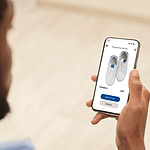The eCommerce Website Guide for High-Traffic Sales Events
The Ultimate Checklist for Ecommerce Success During High-Traffic Sales Events! Dive into our comprehensive checklist tailored for ecommerce brands of any scale, designed to steer you through the overwhelming tide of tasks, from technical tweaks to logistical leaps, during peak sales seasons.
Is Your Website Ready to Welcome a Traffic Rush?
High-traffic sales events can take its toll on performance. Meanwhile you want to create an amazing online experience for this influx of customers. Since we are in the business of making websites more efficient and effective, we created this guide to help you prep for high-traffic eCommerce events, covering tech, marketing, CX, and logistics. We’ve brought highlights from experts in related areas so you get a wide-range of insights. Use it to identify needs, optimize speed, and improve the buying process. Start early and talk to us about AI-media optimization as part of your plan.

Creating a Sales-Event Checklist for Your Website
For high-traffic events, we suggest you create a comprehensive checklist with essential tasks and optimizations for your website. We’ve gathered insights from industry experts.
Some key areas to explore more in depth below:
- Sales Strategy: Define your sales strategy and understand how your website can best embody it.
- Website-Driven Marketing: Identify ways in which your website can bolster and refine your overall marketing strategy.
- Technical Preparedness: Address essential technicalities that are paramount during high-traffic events.
- User Experience (UX) Focus: Consider the user journey at every touchpoint, ensuring intuitive navigation and layout.
- Optimized Media & Delivery: Enhance user experience and brand perception with high-performance images and videos.
- Analytics & Tracking: Implement Google Analytics and GTM effectively to gain insights and understand customer behavior.
- Customer Success Optimization: Utilize your website to offer effective support, information, and post-purchase assistance.
- Future-Proof SEO: Incorporate SEO best practices that provide immediate benefits and lay the groundwork for long-term gains.
- Streamlined Shipping & Logistics: Prioritize efficient and transparent shipping methods and logistics to meet heightened demand.
- Post-Event Debriefing: Have a strategy in place to analyze website performance post-event, allowing for future improvements.
By following your checklist, you can ensure your website is fully prepared for both immediate demands of the event and sustained success in the future, providing a smooth and enjoyable shopping experience for your customers.

eCommerce Sales Strategy
For any high-traffic sales event, optimizing traffic for sales is crucial. A well-planned strategy can boost revenue. Check these key points for success:
◻ Diversify revenue streams: Utilize multiple sales channels such as B2B, B2C webshops, and marketplaces to reach a wider audience and generate more sales. –Rogier Ikink, Marketing Manager, Gorilla Wear on How to Get a Competitive Edge on Black Friday
◻ Create a release schedule for deals: Consider profitability, customer-centric demand, and competitive advantage when deciding when to release deals.
◻ Tiered Discounts: Set up tiered discount structures to reward customers who purchase more items. For Magento users, Amasty’s Promotion Suite Pro can be used to create tiered discounts. – Anastasia Yaskevich, Content and Communications Specialist, Amasty
Create Deals that your customers will love – it’s not just about clearing out inventory. Rogier Ikink, Marketing Manager, Gorilla Wear on How to Get a Competitive Edge on Black Friday
Advice from Nati Tedeschi, Strategic Partnerships Lead @ BeProfit:
◻ Leverage product bundles: Bundle best-selling and profitable products to increase sales and profits. Analyze your numbers to identify your top-selling and most profitable products. Draw in consumers by featuring your popular items and pairing them strategically with your most profitable products. Read More
◻ Strategize discounts effectively: Analyze past discounts to identify the most effective ones. Consider pairing discounts with less-margin-depleting hooks, such as free gifts or tiered discounts. Read More
◻ Excess stock: Clear out excess inventory as part of your event’s profit-optimization strategy. Identify products that would perform better in a sale, such as those that have been on the site for over 90 days, have a higher days-to-finish inventory than the shop average, and don’t yet have a discount. Read More
◻ Monitor profitability: Keep a close eye on profitability, not just gross sales. This involves tracking the net revenue after deducting costs like discounts, marketing, shipping, and handling. It prevents you from being misled by high sales volumes that don’t translate into actual profit, ensuring that your event’s success is genuine and financially sustainable.
◻ Analyze return rates: Identify products that are returned more often and why. Take steps to reduce return rates, such as improving product descriptions or offering more flexible return policies. Use SpeedSize for fast-loading, high-quality product images and videos to educate the customer before purchasing to avoid high returns.
◻ VIP Rewards: Create a VIP strategy to reward your most loyal customers during the sale event. Offer exclusive perks like private collections, VIP gifts, doubled loyalty points, and early-bird specials.
Marketing Strategies for eCommerce
Marketing is key for bringing the right traffic and converting those visitors. Get the most out of your event with data-driven strategies, past insights, AI content creation, early planning and more. These tips are just a glimpse; dive into our dedicated Marketing Strategies article to maximize your marketing impact for high-traffic events.
Read: Marketing Tips to Prepare Your eCommerce Website for High-Traffic Events

Technical Action Items

For an in-depth guide on technical strategies to optimize your ecommerce site’s performance during high-traffic sales events, check out our dedicated article. Here are just a few:
- Infrastructure stability test
- Pre-Event Performance Audit
- Lazy Loading for non-LCP media
- Caching tips… and much more!
User Experience (UX) Tips for eCommerce
With a high-traffic sales event approaching, prioritize enhancing user experience. An optimized site not only handles traffic but also boosts conversions. Prepare to welcome, understand, and empower visitors. Explore our UX guidelines for standout strategies.
Read: How to Get Your Website UX-Ready for eCommerce Sales Events

Website Media & Delivery
For any high-traffic sales event, your website’s visual content is crucial. Optimize media content as part of your event strategy. Talk to our team to automatically upgrade your website’s media compression and delivery with our no-code AI tech.
◻ Leverage AI-Precision Quality:
Elevate your e-commerce site with sharp images and videos to showcase products effectively. This approach boosts user engagement, builds trust, and can decrease returns by providing a clear expectation of the product. It also enhances conversion rates and promotes social sharing, broadening your customer base. Reevaluate the compression tools you are currently using and upgrade to an AI platform like SpeedSize so high-quality won’t compromise site speed.

◻ Use Next-Gen Formats for images and videos:
Next Gen Formats refers to the latest image and video formats that offer superior file compression and quality compared to traditional formats, leading to faster loading times and an improved user experience. Examples include WebP, AVIF, and HEVC for images and videos, respectively.
◻ Automate multiple transformations of media files:
Apply various transformations to media files, such as format conversion, compression, resizing, cropping, watermarking, flipping, rotating, and more. Automating these processes not only saves time and resources but also ensures consistency and optimal loading speeds across your product images and videos. SpeedSize streamlines these processes – ask us how.
◻ Implement responsive images:
Define the necessary response headers on your server and using the “sizes” attribute on your image elements. This technical adjustment ensures that your website displays images that are optimized for the user’s device. It can improve the browsing experience and positively impact your site’s SEO.
◻ Optimize File Sizes:
Reduce media file sizes on your e-commerce website to quicken load times and improve user engagement. This boosts page performance, helps in SEO, and caters better to mobile users, likely increasing sales and customer retention. Make sure you don’t lose quality with outdated compression tools – use SpeedSize instead.
◻ Implement autoplay videos on product pages:
Engage visitors by automatically playing videos when they land on your e-commerce site. This visual engagement can quickly highlight product features, demonstrate use cases, and create an immersive experience. Benefits include increased time on page, improved conversion rates, and enhanced user engagement, leading to a more dynamic shopping experience that can help products stand out in a crowded online marketplace.
◻ Use Edge CDN Adaptive Delivery:
Ensure fast and reliable content delivery regardless of user location and device, with reduced latency. This technology dynamically adjusts content delivery to the user’s device and network conditions, optimizing the browsing experience. Adopting SpeedSize with Edge CDN Adaptive Delivery can provide a competitive edge by delivering content more efficiently to users globally.
◻ Adaptive Media Formats
Serve media in the most compatible format, size, and resolution for each user’s device and browser for optimal viewing. Get faster loading times, reduced bandwidth usage, and an improved overall user experience, which can lead to increased engagement and higher conversion rates.
◻ Consider best-practices for product videos:
Hook the viewer with a strong intro; Communicate a clear message; Show how your product solves a problem; Use relatable characters; Practice your script beforehand; Keep your video short and to the point; Use high-quality video and audio; Include customer testimonials. Source: Shopify. In fact, SpeedSize enables brands to use high-quality autoplay videos with a no-code integration that won’t slow down your website loading.
◻ …and for Product Images:
Product images should be consistent in design. High-quality. Use a white background. Show multiple angles of your product. Include close-up photos of important details. Use lifestyle photos to show how your product can be used in everyday life. Edit your photos to adjust the brightness, contrast, and colors. Optimize your images for SEO. Use SpeedSize to ensure the highest quality-to-file size ratio among all compression tools, responsive, next-gen formats, and other features to get the most of your product images. Source: Shopify
Google Analytics & Tracking
Accurate tracking is essential for optimizing high-traffic sales events. Google Analytics and GTM are key. They provide insights to refine your strategy. Follow these pointers for better tracking during peak sales events.
◻ Verify Conversion Tracking: Ensure that all conversion tags within Google Tag Manager (GTM) are correctly set to activate during key purchase events, ensuring accurate data capture.
◻ Audit Event Tracking: Periodically assess important interactions such as product selections and cart additions within GTM to ensure consistent and accurate event tracking. Well-planned events have milestones and expectations for each phase of the experience. – Manuel Nicanor GIoffré, Commercial Director, Improntus
◻ Implement Custom Alerts: Get notified of significant traffic spikes or drops. Staying informed in real-time allows for immediate response to potential issues, such as website outages or server overloads during traffic surges, and helps in identifying underperforming campaigns promptly.
◻ Ensure user analytics and tracking is consistent across all your domains and subdomains. This is crucial for ecommerce websites that span multiple online properties, as it allows for seamless tracking of customer journeys, regardless of how they navigate between your sites.
◻ Create Custom Reports in Google Analytics: Analyze Black Friday traffic and conversion trends, allowing for adjustments to marketing strategies based on data insights. Not only can it lead to a more effective allocation of your advertising budget, but it can also help tailor the shopping experience to meet customer demands, potentially increasing sales and improving the overall effectiveness of your campaigns. – Anastasia Yaskevich, Content and Communications Specialist, Amasty
◻ Monitor Real-time Traffic during the Event: Leverage GA’s real-time functionality to closely monitor website activity during peak times. This aids in immediate detection and resolution of any potential tracking inconsistencies.
Customer Support on eCom Websites
In high-traffic sales events, trust is vital. Seamless customer support eliminates doubt, reduces friction, and fosters brand loyalty. Here’s how your website can excel in customer success during these events:
◻ Easy-Access Support: Make it easy for customers to reach out during the high traffic period by prominently displaying customer support channels on your website. Make sure “Help” or “Support” buttons are clearly accessible from all pages of the website, especially on checkout pages. Consider adding a dedicated channel for that particular sale event about related issues.
◻ Address common questions, feedback and complaints: Prioritize solutions for issues from previous years, well in advance. Create readily-accessible content to respond quickly should they repeat this year. Address these issues in FAQ sections and chat support.
◻ Collect Feedback: Actively seek out opinions from your online shoppers to gain insights into their experience on your website. Focus on continual feedback collection to enhance user satisfaction, with particular attention during major events. After the sale ends, gather post-purchase reviews to inform improvements for future events.
◻ On-Call Schedule & Extended Support Hours: Create an on-call schedule for your sales and customer support teams to ensure there is always someone available to answer customer questions and resolve issues.
◻ FAQ Section: Update the FAQ section addressing common sale-related questions to reduce support tickets and customer frustration.
◻ Live Chat Capabilities: Implement Live Chat with support agents or develop the capabilities of chatbots. Provide customers with convenient and timely support by offering 24/7 live chat or chatbot assistance. It could increase customer satisfaction, reduce bounce rates as queries are resolved quickly, and potentially improve conversion rates as customers receive timely help during their purchase decision process. Live support can also gather real-time feedback and data, so you can adapt and tailor your offerings more effectively.
◻ Clear, Realistic Delivery Times: Manage customer expectations about delivery times by clearly displaying them on your website. Be realistic about your capabilities and don’t over-promise. If necessary, hire additional warehouse personnel to handle the increased order volume during sale events like Black Friday or Holiday seasons. – Manuel Nicanor Gioffré, Commercial Director, Improntus
◻ Easy-Access to Policies: Clearly detail the return, exchange, and refund processes related to the event on your website to reduce the number of related inquiries. Make sure it is easy to find from all pages and add it to the FAQ sections.
◻ Full Transparency for Technical Issues: If your website does suffer any website slowdowns or technical issues, keep your customers informed. Use clear messaging on your website with banners and notifications, social media channels, and email marketing to manage customer expectations and provide updates on the situation.
eCommerce SEO for the Long-Term
High-traffic sales events aren’t just short-term boosts; they lay the SEO foundation for lasting success. Maximize immediate gains and ensure long-term growth by preparing and following best practices: SEO eCommerce Website Checklist


Inventory, Shipping etc.
◻ Fast-shipping features: Offer free ultra-fast shipping to exceed customer expectations and boost profitability. Analyze data to understand how shipping choices impact customers and profitability. Read More – Nati Tedeschi, Strategic Partnerships Lead, BeProfit
◻ Find your most profitable shipping method: Offer the carrier’s highest gross margin shipping method for free in as many locations as possible. Read More – Nati Tedeschi, Strategic Partnerships Lead, BeProfit
◻ Leverage multiple locations for warehousing, sales, and fulfillment: Consider international partnerships to broaden your reach. – Colin Vleerbos, Senior Marketeer, Gorilla Wear on How to Get a Competitive Edge on Black Friday
◻ Confirm stock levels for anticipated sales: Alert customers if certain products might have longer delivery times.
◻ Track inventory levels in real time: Implement tracking tools like WooCommerce Stock Manager to keep a live check on your stock. They can help prevent overselling, quickly identifies popular items for restocking, and streamlines supply chain management, ultimately saving costs and boosting customer satisfaction.
Post-Event Debriefing
After the sales event frenzy, ecommerce businesses shift focus to post-event analysis. Dive into analytics to refine strategies for future high-traffic sales events, leveraging insights for improved outcomes.
◻ Sales Performance Analysis: Analyze the sales data to assess the effectiveness of your event-focused campaigns, identify trends, and highlight top-performing items. This analysis helps tailor future campaigns, stock popular items, and increase profits. Understanding customer preferences from this data is crucial for planning and improving future sales strategies.
◻ Web Traffic and Conversion Analysis: Assess the patterns of web traffic and conversion metrics to identify user behavior and notable drop-off points. Identify areas for improvement and opportunities for next year.
◻ Media Performance Review: Review media components’ load times and user interactions to optimize for improved engagement and performance.

◻ Customer Feedback and Reviews: Collect and evaluate feedback from customers about their shopping experience during the event to enhance future interactions.
◻ Inventory and Logistics Review: Analyze the efficiency of inventory management and logistics during the sale period, focusing on potential areas for improvement in stock availability and delivery.
◻ Competitive Intelligence: Benchmark your performance against competitors to identify areas for improvement. What promotions, technologies, channels did they leverage?
CONCLUSION
In preparation for any bustling sales event, address your ecommerce site comprehensively. Weave sales strategies into your website, optimize user experience, ensure technical robustness, and use analytics. Build trust with secure payments, efficient logistics, and support. Post-event review is key for growth. Book a consultation meeting with SpeedSize now to ensure your media and content delivery are primed for upcoming high-traffic events, amplifying your chances of outshining in the ecommerce arena.




